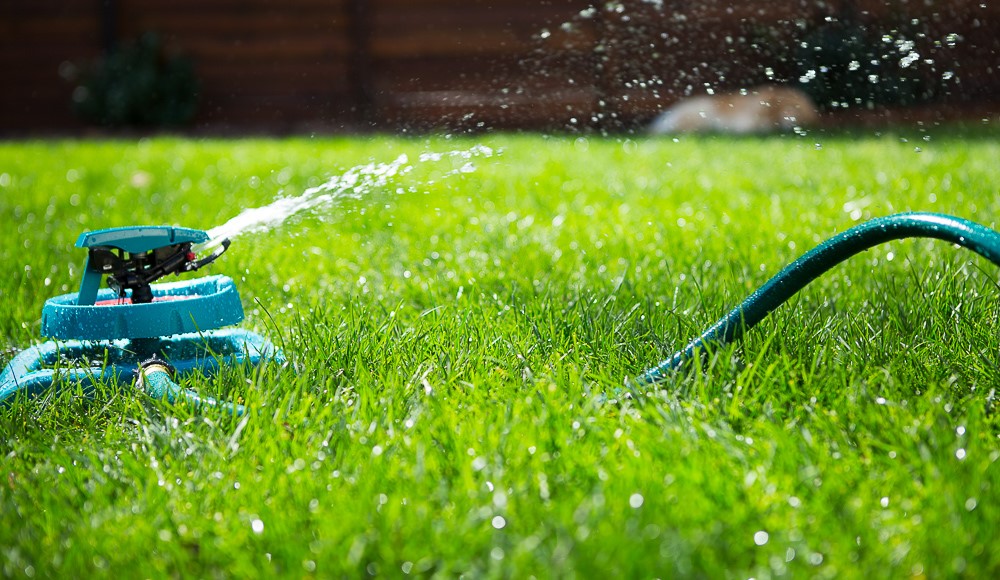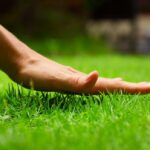The heat is here, and it is important to remember some important things about your lawn and the health of your grass, as we enter the hottest time of the year.
Cool-Season Grass
The first thing to remember, is that your lawn is made up of cool-season grass. More than likely, your lawn has some combination of Fescue, Kentucky Bluegrass or Ryegrass. All of these grasses are a cool-season grass type. This means, that your lawn thrives when the daytime temperatures are around 75 degrees, and the night time temperatures are in the 50’s. If you get too far outside of that window, weird things can begin to happen.
When we enter Winter, your lawn goes to sleep to protect itself from the cold and snow. Likewise, as we enter into the hot Summer, and begin to see temperatures of 90 degrees and higher, your lawn will begin to protect itself again. Both of these cycles of your lawn protecting itself are called dormancy. Dormancy does not mean that your lawn is dead, rather, it just stores all of it’s needed nutrients and moisture where it is most important, down below in the roots. This is why your lawn begins to turn brown in the Summer when the temperatures are high, and water is lacking.
Dormancy is not a bad thing. As mentioned, it is a protective mechanism for the lawn so that it doesn’t die. Sometimes, if dormancy is prolonged over the Summer, without receiving any moisture, eventually small areas can die off. However, this is the exception and not the rule.
So as you begin to see your lawn going dormant, it is important to make a decision on how you would like to care for it. Beginning to add irrigation is a great thing, as long as it is consistent. If you are not able to be consistent with your watering over the Summer, it is best to let your lawn go dormant, and let nature take its course. Bringing your lawn in and out of dormancy by only watering it 1 time every other week will hurt the lawn, more than it will help.
Water Tips
Whether you have an in-ground irrigation system or an above-ground sprinkler attached to a hose, you can achieve the same results. As a general rule, our cool-season lawns need about 1-1.5 inches of water a week. How do you measure this? The best and easiest way is to set out some small tuna cans or trays and see how much they fill up over the course of 30-45 minutes.
During the hot summer months, when rain is slow and the heat is reaching the 90’s, it won’t hurt to bump up to 2 inches of water a week. The key is to watch the weather and water accordingly. If a storm is coming that will bring a half-inch of rain, there is no need to water that day. You want to water about 3 out of 7 days a week. Divide up the amount of water you need to put down over those three days. Such as a Monday, Wednesday, Friday, or Tuesday, Thursday, Saturday. Take those days and divide your total by 3. That’s how much you should water each day. A good rule of thumb is to water just over 1/3 inch of water for those three days of your choosing.
A fun test you can perform on your lawn to make sure your lawn is well irrigated is to push a screwdriver into the ground. If your lawn is properly watered, you should be able to push the screwdriver into the dirt with very little effort.
When?
The timing of watering is just as important as how much water to apply. The best time to water your lawn is in the morning hours. We can’t all get up crazy early in the morning nor do we have the motivation to do so. But the best time would be between 5-7 am. This works best if you have a timer to do this for you. However you are able to achieve it, it is best to water in the morning because you beat the heat of the day, and your lawn has a chance to dry out. If you water late in the evening, you allow that water to sit on your lawn into the night hours which isn’t healthy for the soil or grass and can lead to fungus issues.
Mowing
The way you mow your lawn is also very important in the Summer months. Your lawn can become stressed and very intolerant during hot days. It’s always a safe practice to mow your lawn at higher heights in the Summer. The recommended length is a minimum of 3.5 inches, 4 inches is preferred. This helps the grass withstand summer drought stress and allows it to hold more moisture. The best time to mow your lawn is in the morning or evening. Mowing your lawn in the hottest part of the day exposes new leaf blades to the scorching sun, and can burn your lawn. When your lawn is drying out in the Summertime and wants to get crispy, it’s always best to stay off it when you can and mow less than you would in the Spring and Fall.
Fertilization
In the hot Summer months, understanding fertilizer is important. When your lawn isn’t actively growing like it is in the Fall and Summer, you need to know the best type of fertilizer to use so that you aren’t forcing it to grow when it doesn’t want to.
The Spring and the Fall are great times to use a fertilizer with a higher rate of Nitrogen, pushing that lawn to grow tall and thick, preparing it for the season to come. However in the Summer, you want to back off the amount of Nitrogen that the lawn receives, and focus more on the micro nutrients in the fertilizers such as Magnesium, Sulfur, Iron, etc. These micro nutrients are going to help feed the root system of the lawn and encourage it to have strong all around health, rather than just top growth.
If you are looking for a great fertilizer to use during the Summer time, try to move towards an organic slow release granular product. An organic product is going to be very safe on the lawn during the heat, and the granular product will break down over time so the lawn can use it slowly, rather than applying a product that flushes out all of its nutrients in a short amount of time.
Conclusion
In the end, it is important to remember that your lawn is a living organism. It needs to be taken care of. The less stressed your lawn can be during the Summer, the better it will do. Water as best as you can, mow high, feed correctly, and your lawn will thank you later down the road.



